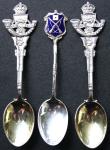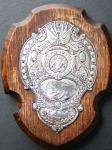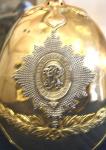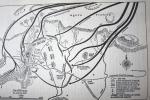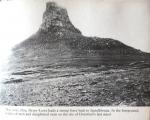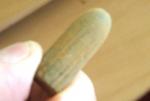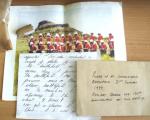-
Posts
13,225 -
Joined
-
Last visited
-
Days Won
22
Content Type
Profiles
Forums
Blogs
Gallery
Events
Store
Everything posted by Mervyn Mitton
-
The two outer spoons are for Durban Light Infantry - you will see their mongram at the top . The motto 'Primus in Africa' is Latin for First in Africa - the two animals are Blue Wildebeeste - the animal logo for Natal. The bowls of the spoons are gilded. The middle spoon was for an earlier date and for shooting at Durban High School for Boys. All for the same person - his name is on the reverse.
-
Sometimes I get more pleasure looking at a collection of different things, then I do with a complicated post. Perhaps it's because I don't have to get too involved. This is such a small collection - all South African in origin - even if the Italian pieces were taken from Italian P.O.W.'s. This first shooting Shield was created by the Cape Shooting Association in the early years of the 20th Century - I think there is probably a large shield and these smaller ones were awarded to each year's champion. Unless this is the main Shield and he won it outright ? He was a shottist with the Durban Light Infantry in the early 1930's - you will see his name on most of the awards. He may even be responsible for taking the war souvenirs if he was fighting in WW2 - I can't remember if they all came-in together. The Shield is hall marked silver and has a lovely designs, including rifles and Zulu spears. The Arms are for Cape Province.
-

Essex Regiment
Mervyn Mitton replied to biz's topic in Great Britain: Research, Documentation & History
Biz - I'm afraid I don't understand why you should post a question - and then, apparantly, not bother to return. Owen went to trouble to find this picture of your Grandfather - which I would regard as an important find. Thankyou Owen. Mervyn -
Jedburgh - your original query has developed into a most interesting and informative post - we must be grateful to Michael for adding his considerable knowledge. I hope you will be able to keep it ticking along with more on the people involved. Myself and Brian would like to consider this for one of our ' Mods' Choice' - however, it will need a little more on the units to give it research potential for future collector's. Mervyn
-
Hello, Miaoulx - a great pleasure to welcome you to our Forum and to find out that the name on the box was for your Grandfather. Your Grandfather had distinguished service and a very good set of medals - I doubt if we will ever know why he had this one ? Certainly the Decoration was too early for him to have had it awarded. I wonder who sold the Group - unfortunately, executors of wills often act without consulting all family members - which is a difficult thing to do, and of course they have no automatic right to them. Dan, one of members did tell me the name and date of the auction - they might be willing to pass a letter from you, to the purchaser and you could ask if they wished to sell - however, they will be expensive. I hope that you will continue as an active member now that you have joined - someone must have mentioned to you about this post ? Strangely, this is by far from being the first time that relatives have turned-up from posts. Let us know if we can assist any further ? Mervyn
-

Question re: a Knuckleduster
Mervyn Mitton replied to Obergefreiter's topic in Swords & Edged Weapons
Obergefeiter - this looks like a fairly standard trench knife from the 1st WW. I can't access Dan's link so am not sure if he is saying it is an American type made by the military ? Most of the people fighting had these made in the base workshops - using standard bayonets cut down. This one looks like the point from a French 'needlepoint' bayonet. The Germans cut down Mausers and we used the Enfield bayonet. I wouldn't try touching it - as Dan says it is a display item . Will be interesting to find out if it was an issue piece ? Mervyn -
The 7th Dragoon Guards were a British Heavy Cavalry Regiment - they were originally formed in 1688 and after helping in the rescue of the Princess Royal - later to become Queen Anne - they were given the title 'The Princess Royal's Own.' I am not planning at this time to go into their distinguished history - however, this helmet was taken apart for cleaning and I thought it might be of interest to see the different constituent parts. Stuart identified it as being an 1870's pattern and being for an officer it is gold plated. This was in order for an officer to be seen easily by his men in the heat and dust of battle. The lovely helmet plate is of silver. I will show the complete helmet and then the different parts. You will note the grey and black plume - this is only for the 7th. The chin chain is in place.
-
The black lines with arrows indicate the path taken by different Impis. The mountain is shown by all the lines and the King's half brother - Dubalamanzi - is shown going behind. From there he continued down Fugitive's Trail and the next morning attacked Rorke's Drift. To the right - but fairly close to the mountain are the squares of the British 24th Regt. In front of them are the NNC - Natal Native Contingents and to their left are the Artillery. When the Zulus attacked the NNC panicked and ran away - this caused confusion with the British. Looking at the British Squares, I think the position that the bullet was found, is roughly where the tent area for the 2nd. Bn. 24th Regt. was standing. When Lord Chelmsford advanced across the plain he left an enhanced Company from the 2nd Battalion to help defend the Camp.. This is not conclusive evidence that the bullet was dropped - or, fired by them. We must consider that perhaps it was a complete bullet and the brass cartridge case had been taken off for scrap - or, it may have been fired from some distance and dropped there. However, this is a well searched area, and the possibility of it being brought there in the more recent past must be considered. However, it is a fired Martini .577/.450 bullet and it does have the rifling marks from the barrel. Perhaps you will never know it's history - but, what a wonderful story goes with it's finding.
-
This rare picture (All taken from The Washing of the Spears by Donald Morris ) shows the battlefield of Isandlawana in May of 1879. The battle itself took place on January 22nd. and it was only in early May that British troops returned to the Field of Battle. Try to enlarge - the whole of the foreground has British bodies and dead oxen. The mountain has always been held to look like a Sphinx.
-
Douglass - I have your emails of the slug and the area. Firstly, I will show your three pictures - and then some photos which may answer your queries. Hopefully, our members will find this of some interest ? This first picture shows the Dundee Diehards - who re-enact the 1879 Battle of Isandlawana - posing in front of the mountain.
-
Nick - all good possibilities. The ancient Town of Poole does tick all of the boxes - however, they denied the missing set hadn't been found. Should it be possible to link it to Poole , then it becomes even rarer. Hopefully the new owner will be able to carry out some research - maybe a local historian could be put to work checking the Poole archives - they go back 800 years.
-
Dan - a very difficult item to value. There is the problem that it is an African (probably) provenance and the metal is not to a high standard. However, the carved wooden Cross is another matter. The carving is well done - it is decorated in the wood and obviously, has a religious connection. I think perhaps your friend needs to do some further research - particularly concentrating on Ethiopia and the areas around. Should he be able to prove this then I think the value is quite high. There is an Ethnographical Museum in London that specialises in things of this type - see if you can look for it's address and send them pictures. Also, why not write to the ArchBishop in Addis Ababa ? Please let me know if you need any help and keep us posted. Mervyn





